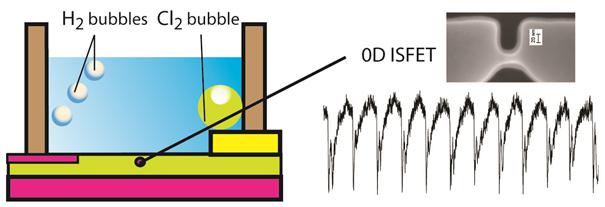Zero-dimensional transistor harvests bubble energy wasted during water electrolysis
A zero-dimensional transistor is placed in contact with a water droplet containing NaCl ions. A current between the anode and cathode generates hydrogen and chlorine bubbles, which the transistor can detect and transform into electric pulses. N. Clément et al. © American Chemical Society
When hydrogen is produced from water during electrolysis, some energy is lost at each bubble emission. In a new study, researchers from the Institut for Electronics Microelectronics and Nanotechnology (CNRS/Univ. of Lille), NTT, Tokyo and CEA Marcoules have demonstrated that 25-nm transistors — so small that they are considered zero-dimensional (0D) — can be used to transform this lost energy into electric pulses. Millions of these 0D transistors could be used to detect individual bubbles and generate electric pulses at an optimal efficiency, gathering part of the energy lost during electrolysis and making it available for other uses. In theory, 2 million 0D transistors could fit below the microbath, which results in an output pulse power of 500 µW and a pulse power efficiency of about 99%.
These results could have a variety of applications, such as lab-on-chip devices for hydrogen emission. Another potential application is in physiology, since the electric signal has a similar amplitude as that of the action potential in a neuron.
This paper was published in Nanoletters : Water Electrolysis and Energy Harvesting with Zero-Dimensional Ion-Sensitive Field-Effect Transistors. N. Clément, K. Nishiguchi, J.F. Dufrêche, D. Guérin, A.Fujiwara & D. Vuillaume. Nano Letters 13(8), 3903-3908 (2013), http://dx.doi.org/10.1021/nl4019879
Contact : N. Clément (nicolas.clement@iemn.univ-lille1.fr / 03 20 19 79 32)















